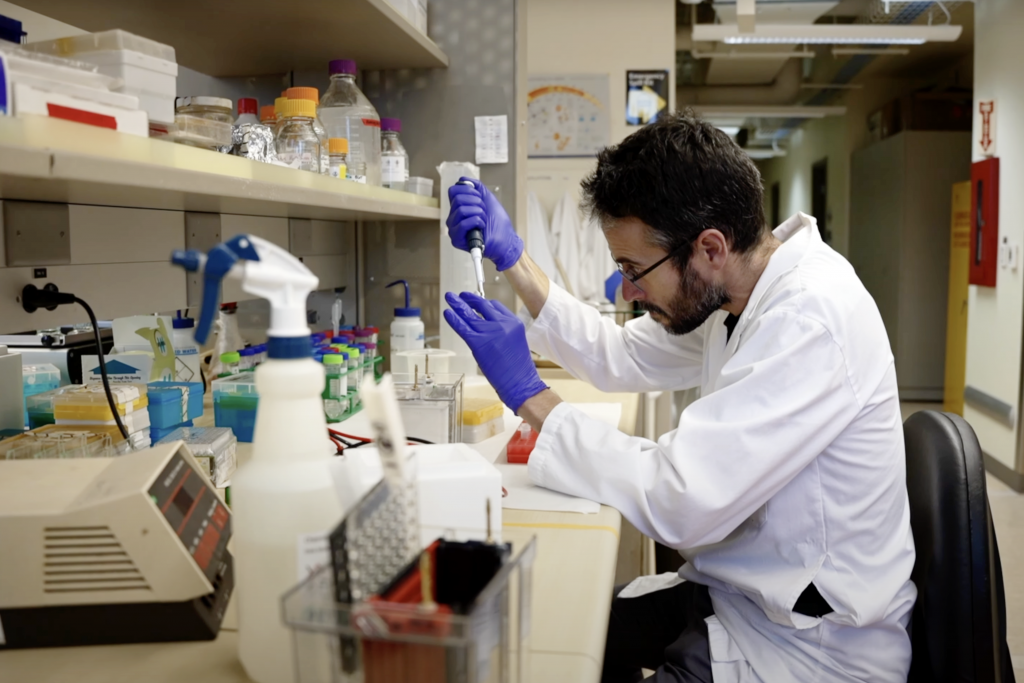
Oscar Seira, Mitacs Invention to Innovation (i2I) finalist in 2022. Seira presented the initial commercialization strategy for an injectable and functionalized biomaterial for spinal cord injury repair.
The quest to repair severed spinal cords has brought together the brightest minds from across institutions and disciplines in a spinal cord injury research program, Mend the Gap, that was recently awarded $24 million in government funding from Canada’s New Frontiers in Research Fund (NFRF).
SFU Beedie’s Invention to Innovation (i2I) program played a key part in landing this funding for Mend the Gap because the training advances research as well as broadening researcher career paths. SFU Beedie partners with national research organization, Mitacs, to transform breakthrough scientific research into real world applications. Over the course of seven months, the Mitacs i2I skills training provides innovation and entrepreneurship training for scientific researchers to help them commercialize their inventions.
“Mitacs i2I is a uniquely Canadian solution helping researchers in universities across the country shape science innovation from the earliest stages, while still embedded in the research lab,” says Elicia Maine, SFU Beedie’s W. J. VanDusen Professor of Innovation and Entrepreneurship and AVP of Knowledge Mobilization and Innovation at SFU. “The entrepreneurial mindset developed in these researchers through the award-winning program impacts future research direction, the technological attributes which are optimized, and which initial applications are prioritized. Participants also develop translational skills, enabling research scientists to contribute to new product development and commercialization in industry.”
Maine is also a member of the team at Mend the Gap. A six-year project with lofty goals that aims to repair the spinal cord after injury, the project is structured to address a range of problems facing both spinal cord injury patients and the broader population. Mend the Gap is composed of 12 academic institutions across five countries, bringing together top researchers across a range of disciplines as well as three Canadian non-profit and charitable organizations.
“The project builds on a century of research and brings together the unprecedented diversity of expertise in neurobiology, biomedical engineering, ethics, robot-assisted surgery, and rehabilitation needed to repair injured spinal cords,” says John Madden, program director at Mend the Gap. “The collaboration and an ability to translate our research into solutions for real world problems is essential. Scientists working in a lab benefit from developing the mindset to perceive the scope of problems that their research could address.”
This is exemplified by Justin Wyss, one of Madden’s students and a recent graduate of the i2I program, who developed a sensor sheet that aims to prevent pressure sores for those who use wheelchairs. “Our i2I team members bring a different approach by putting their research directly in the hands of practitioners,” says Madden. “This accelerates the path to translation.”
Another Mend the Gap team member, Oscar Seira, presented the initial commercialization strategy for an injectable and functionalized biomaterial for spinal cord injury repair as a finalist in this year’s Mitacs i2I program closing event. A neuroscientist at leading spinal cord injury research institute, ICORD, Seira focuses on neural repair by using biomaterials that are selected with respect to translational considerations.
“The i2I program has changed my view of research and innovation by helping me see the bigger picture,” says Seira. “Although the [Mend the Gap] project is still in its early stages, an early and strong understanding of the steps towards commercialization and the challenges that we may face is immensely valuable”.
The key to the Mend the Gap project will be a gel biomaterial that can be safely injected into the spinal cord to support neural repair. Along the way, there may be opportunities in the future to commercialize the associated technologies, similarly to the way technologies like Teflon, originally used for industrial purposes, became commercialized in a wide range of products such as non-stick pans and surgical equipment.
To learn more, follow the Mend the Gap project on Twitter or Instagram. The next cohort of the Mitacs Invention to Innovation (i2I) Skills Training is accepting applications until July 31st.